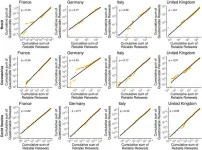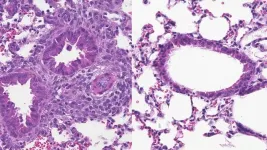(Press-News.org) A group of researchers at the University of California San Diego School of Medicine led an investigation that offers new insight into the causes of spina bifida, the most common structural disorder of the human nervous system.
Work of the group, led by Keng Ioi Vong, Ph.D., and Sangmoon Lee, M.D. Ph.D., both from the laboratory of Joseph G. Gleeson, M.D., at the UC San Diego School of Medicine Department of Neurosciences and the Rady Children’s Institute for Genomic Medicine, reveals the first link between spina bifida and a common chromosomal microdeletion in humans. The study demonstrates that individuals carrying this chromosomal deletion —present in one of 2,500 live births — demonstrate a risk of spina bifida more than 10 times greater than the general public.
The study also underscores the potential role of a common food supplement in reducing the risk of spina bifida. The findings were recently published in the journal Science.
Gleeson, Rady Professor in the Department of Neuroscience and director of neuroscience at Rady Children's Institute for Genomic Medicine, is the senior author of the study. He explained that spina bifida, also known as meningomyelocele, affects one in every 3,000 newborns. Unfortunately, the causes are mostly unknown. A few mutations were reported but could only explain a tiny fraction of risk, Gleeson added.
To uncover the genetic causes of the disease, Gleeson’s UC San Diego lab joined with colleagues from across the globe to establish the Spina Bifida Sequencing Consortium in 2015. The consortium began focusing on a tiny deletion in chromosome 22. Chromosome microdeletions refer to a condition in which several genes in a chromosome are missing. The group’s target condition, known as 22q11.2del, has been implicated in a number of other disorders. They began looking for 22q11.2del in spinal bifida patients.
“All patients we recruited have the most severe form of spina bifida, and all underwent best-practice comprehensive genomic sequencing,” Gleeson said. “We identified 22q11.2del in 6 out of 715 patients. This may not seem a high percentage, but this is by far the most common single genetic variation that could contribute to spina bifida.”
He went on to say the group identified eight additional spina bifida patients who carried the deletion from a cohort of approximately 1,500 individuals recruited because of the presence of the common 22q11.2 deletion, Gleeson said.
The researchers then narrowed the cause among the many genes in the 22q11.2 deletion to a single gene known as CRKL. Gleeson explained that there are nine other genes in this chromosomal region that could have been the cause. He said the team began a process of elimination, “knocking out” each of the mouse genes one-by-one, when they received a fortuitous email from Dolores Lamb from Weil Cornell College of Medicine. Lamb had noted some of the mice in their vivarium that were missing Crkl and showed spina bifida. (Vong explained that researchers use all capital letters to describe the gene in humans, and lower-case for mice. )Lamb’s group heard about the Gleeson lab project throughs the Spina Bifida Association.
“This finding really got us excited because it meant that CRKL disruption might be sufficient for spina bifida,” said Vong, co-first author of the study. “We removed the mouse Crkl gene ourselves and confirmed that some of the mice developed neural tube defects, including spina bifida.” Most of the other genes in 22q11.2 deletion were subsequently excluded, he added.
They next turned their attention to how folic acid may modulate CRKL-mediated spina bifida. Vong noted that prior studies in humans demonstrated that folic acid (also known as vitamin B-9) supplementation prior to conception reduces the incidence of spina bifida and other neural tube defects by up to 30-50 percent, but the mechanisms are still a mystery.
“When we deprived the Crkl mutant female mice of folic acid in their chow, many more of their offspring had neural tube defects, and the severity increased dramatically,” Vong explained. “This suggests that folic acid taken by pregnant women may not only reduce the risk, but also the severity of neural tube defects in their offspring.”
“We hope our findings can help the research community to better understand causes of neural tube defects, especially the causes attributable to common genetic findings like 22q11.2 deletion,” Gleeson said. “We also hope our findings can contribute to healthy pregnancies, improved women’s health, and improved outcomes for children.”
Co-authors associated with the University of San Diego School of Medicine Department of Neurosciences, as well as with Rady Children’s Institute for Genomic Medicine, (in addition to Joseph G. Gleeson Sangmoon Lee and Keng Ioi Vong) are: Renee George, Bryn Gerding, Kiely N. James, Valentina Stanley, Nan Jiang, Kameron Alu, Naomi Meave, Fiza Jiwani, Isaac Tang, Ashna Nisal, Ishani Jhamb, Arzoo Patel, Aakash Patel, Jennifer McEvoy-Venneri, Chelsea Barrows, Celina Shen, Yoo-Jin Ha and Robyn Howarth. Other co-authors include Hal S. Meltzer, of the University of California San Diego Rady Children’s Hospital Department of Neurosurgery; Anna S. Nidhiry, of Rady Children’s Institute for Genomic Medicine; and the Spina Bifida Sequencing Consortium.
This work was supported by the Center for Inherited Disease Research grant HHSN268201700006I, the Yale Center for Genomic Analysis, the Broad Institute, the UC Irvine Genomics Core, the UCSD Institute for Genomic Medicine, the UCSD Transgenic Core, UCSD Microscopy Core grant P30 NS047101, and Columbia Microscopy Core grant S10 OD032447- 01. Other support came from the National Institutes of Health, including National Institute of Diabetes and Digestive and Kidney Diseases, and by support from the Howard Hughes Medical Institute and Rady’s Children Institute for Genomic Medicine to Joseph G. Gleeson.
# # #
END
New insight into genesis of spina bifida
UC San Diego School of Medicine researchers identify chromosomal microdeletion, say a common vitamin may help prevent condition
2024-05-08
ELSE PRESS RELEASES FROM THIS DATE:
The spread of misinformation varies by topic and by country in Europe
2024-05-08
The eventual prevalence of a piece of misinformation may depend on its topic and the country in which it spreads, with notable differences between the UK, Germany, France and Italy, according to a study published May 8, 2024 in the open-access journal PLOS ONE by Fabiana Zollo from the Ca’ Foscari University of Venice, Italy, and colleagues. This finding suggests that policies to combat misinformation and polarization may need to be context-specific in order to be effective, the authors say.
Researchers analyzed ...
Pacific Oyster density has increased up to 32-fold across a decade in some California waters, and coincides with summer seawater temperature increases of 2-4°C
2024-05-08
Pacific Oyster density has increased up to 32-fold across a decade in some California waters, and coincides with summer seawater temperature increases of 2-4°C
###
Article URL: https://journals.plos.org/plosone/article?id=10.1371/journal.pone.0302935
Article Title: Intra-decadal increase in globally-spread Magallana gigas in southern California estuaries
Author Countries: USA
Funding: “Funding was provided by CSU Fullerton and via subcontracts with Merkel & Associates, Inc. and Port of San Diego to DCZ. Funders had no involvement in the study design or data collection process.” The funders had no role in study design, data collection ...
The EU could mitigate climate change equivalent to 13% of its agricultural greenhouse gas emissions by planting cover crops on bare soil before maize
2024-05-08
The EU could mitigate climate change equivalent to 13% of its agricultural greenhouse gas emissions by planting cover crops on bare soil before maize
###
Article URL: https://journals.plos.org/plosone/article?id=10.1371/journal.pone.0302139
Article Title: Cover crops support the climate change mitigation potential of agroecosystems
Author Countries: Germany
Funding: The research was funded by the German Federal Ministry of Education and Research within the Project "CATCHY", project number: 031B1060C. The funders had no role in study design, data collection and analysis, decision ...
Strengthening CAR-T therapy to work against solid tumors
2024-05-08
May 8, 2024—(BRONX, NY)—Researchers at the National Cancer Institute-designated Montefiore Einstein Comprehensive Cancer Center (MECCC) have shown that a breakthrough therapy for treating blood cancers can be adapted to treat solid tumors—an advance that could transform cancer treatment. The promising findings, reported today in Science Advances, involve CAR-T cell therapy, which supercharges the immune system to identify and attack cancer cells.
“CAR-T cell therapy has revolutionized ...
Exercise, new drug class recommended for management of hypertrophic cardiomyopathy
2024-05-08
The American College of Cardiology (ACC) and the American Heart Association (AHA) today released a new clinical guideline for effectively managing individuals diagnosed with hypertrophic cardiomyopathy (HCM). The guideline reiterates the importance of collaborative decision-making with patients who have HCM and provides updated recommendations for the most effective treatment pathways for adult and pediatric patients.
HCM is an inherited cardiac condition most often caused by a gene mutation that makes the heart muscle too thick (hypertrophy), which impairs its ability to adequately pump blood throughout ...
Study: Heavy snowfall and rain may contribute to some earthquakes
2024-05-08
When scientists look for an earthquake’s cause, their search often starts underground. As centuries of seismic studies have made clear, it’s the collision of tectonic plates and the movement of subsurface faults and fissures that primarily trigger a temblor.
But MIT scientists have now found that certain weather events may also play a role in setting off some quakes.
In a study appearing today in Science Advances, the researchers report that episodes of heavy snowfall and rain likely contributed to ...
USC study reveals role of iron in allergic asthma and points to potential new therapies
2024-05-08
New USC research shows that iron serves as a gas pedal driving certain immune cells that cause inflammation in the lungs during an allergic asthma attack – and blocking or limiting iron may reduce the severity of symptoms.
During an attack, immune cells known as group 2 innate lymphoid cells (ILC2s) can become overactive, causing excessive inflammation and a tightening of the airways, making it difficult to breath. However, the underlying biology is poorly understood.
Now, researchers from the Keck School ...
SARS-CoV-2 and type 1 diabetes in children: new study aims to explore the relationship
2024-05-08
Type 1 diabetes is an autoimmune disease that leads to disrupted glucose metabolism. It requires lifelong insulin therapy. The Global Platform for the Prevention of Autoimmune Diabetes (GPPAD) collaborates within a European network to develop new methods to prevent this condition which is, to date incurable. AVAnT1A is GPPAD's third intervention study. It will investigate whether vaccination against SARS-CoV-2 in the first year of life can protect children who have an increased genetic risk for type 1 diabetes from developing the condition. The study is supported by funding from The Leona M. and Harry B. Helmsley ...
ECOG-ACRIN adds another trial to the ComboMATCH precision oncology study platform
2024-05-08
Another ECOG-ACRIN Cancer Research Group (ECOG-ACRIN) treatment trial is open as part of the ComboMATCH precision medicine study platform. ComboMATCH-E5 is evaluating treatment for patients with KRAS G12C-mutated advanced solid tumors with two different targeted drugs given together. The two drugs include the KRAS G12C inhibitor sotorasib and panitumumab, a human monoclonal antibody antagonist specific to the epidermal growth factor receptor (EGFR). Each drug is approved by the US Food and Drug Administration (FDA) as single-agent therapy for particular cancer types.
"Given the preclinical data demonstrating EGFR over-dependency ...
UT Institute of Agriculture invests in premier poultry research facility
2024-05-08
Poultry production and processing is a $10 billion industry in Tennessee, with more investment expected. To support the future of the industry, the University of Tennessee Institute of Agriculture is investing in the construction of a state-of-the-art, next generation poultry research and education facility at its Middle Tennessee AgResearch and Education Center in Spring Hill.
On Thursday, May 2, nearly 100 state and local officials and members of the poultry production and processing industry joined university officials to celebrate the official groundbreaking for the new project. Four commercial-size (54’ ...
LAST 30 PRESS RELEASES:
Tracing the quick synthesis of an industrially important catalyst
New software sheds light on cancer’s hidden genetic networks
UT Health San Antonio awarded $3 million in CPRIT grants to bolster cancer research and prevention efforts in South Texas
Third symposium spotlights global challenge of new contaminants in China’s fight against pollution
From straw to soil harmony: International team reveals how biochar supercharges carbon-smart farming
Myeloma: How AI is redrawing the map of cancer care
Manhattan E. Charurat, Ph.D., MHS invested as the Homer and Martha Gudelsky Distinguished Professor in Medicine at the University of Maryland School of Medicine
Insilico Medicine’s Pharma.AI Q4 Winter Launch Recap: Revolutionizing drug discovery with cutting-edge AI innovations, accelerating the path to pharmaceutical superintelligence
Nanoplastics have diet-dependent impacts on digestive system health
Brain neuron death occurs throughout life and increases with age, a natural human protein drug may halt neuron death in Alzheimer’s disease
SPIE and CLP announce the recipients of the 2025 Advanced Photonics Young Innovator Award
Lessons from the Caldor Fire’s Christmas Valley ‘Miracle’
Ant societies rose by trading individual protection for collective power
Research reveals how ancient viral DNA shapes early embryonic development
A molecular gatekeeper that controls protein synthesis
New ‘cloaking device’ concept to shield sensitive tech from magnetic fields
Researchers show impact of mountain building and climate change on alpine biodiversity
Study models the transition from Neanderthals to modern humans in Europe
University of Phoenix College of Doctoral Studies releases white paper on AI-driven skilling to reduce burnout and restore worker autonomy
AIs fail at the game of visual “telephone”
The levers for a sustainable food system
Potential changes in US homelessness by ending federal support for housing first programs
Vulnerability of large language models to prompt injection when providing medical advice
Researchers develop new system for high-energy-density, long-life, multi-electron transfer bromine-based flow batteries
Ending federal support for housing first programs could increase U.S. homelessness by 5% in one year, new JAMA study finds
New research uncovers molecular ‘safety switch’ shielding cancers from immune attack
Bacteria resisting viral infection can still sink carbon to ocean floor
Younger biological age may increase depression risk in older women during COVID-19
Bharat Innovates 2026 National Basecamp Showcases India’s Most Promising Deep-Tech Ventures
Here’s what determines whether your income level rises or falls
[Press-News.org] New insight into genesis of spina bifidaUC San Diego School of Medicine researchers identify chromosomal microdeletion, say a common vitamin may help prevent condition








